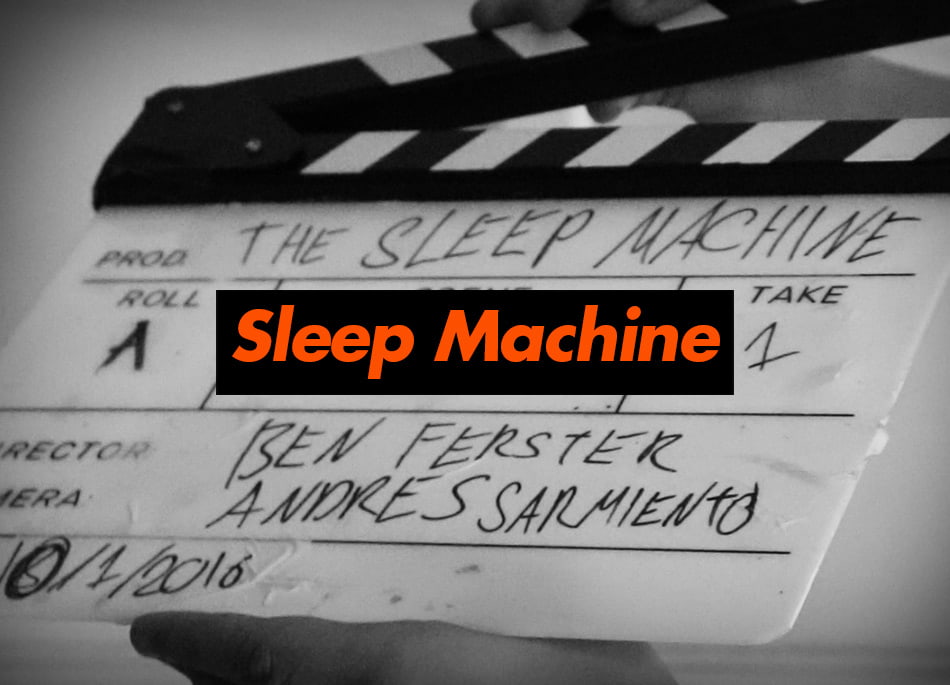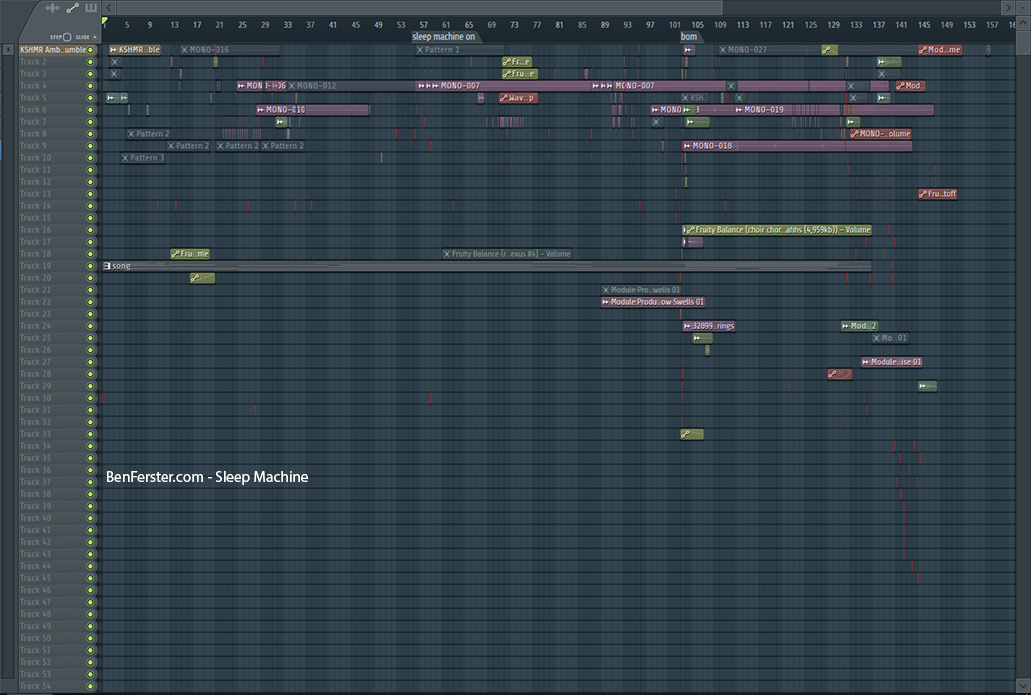In the beginning
In 2006, I caught the filmmaking bug. It was the first thing I was ever passionate about; the only thing I wanted to do with my life. I read so many books on so many disciplines in the film world. I rewatched all my favorite movies with the director’s commentary track on. I wrote some really awful material. In those formative high school years, there really wasn’t much else that I thought about. It wasn’t working in the film world or watching movies that excited me. It was the art of making movies. I never wanted a “job” in film, I only wanted to be instrumental in their creation. To me, that meant directing or producing. I would rather be doing something completely different in life than “pulling cables on someone else’s movie”, as Robert Rodriguez put it.
Fast forward…
9 years later. In that time I had done a couple awful shorts, some spec commercials, irregular video jobs here and there, and worked as a PA on some massive productions. Film was still a huge part of my life, but I hadn’t really taken the initiative to work on something substantial for myself.
In December 2015, I left an awful job and started freelancing as a designer and copywriter. I had enough clients to keep me busy and save some money, but I wanted some time to do things for myself. The path from high school to college to working full time was too linear and rushed, and I felt like I had not been able to take a deep breath in a long time. So during this time I was freelancing, seeing friends, and working on various creative projects. All in all, it was a really productive and happy time for me.
The Collective
On August 25, 2016, a friend of mine (and eventual co-producer of this film) did a Facebook Live video of what looked like some sort of production meeting. I asked him about it, and he said he was starting a film collective with Kiaro Pictures and invited me to the next meeting.
I jumped at the opportunity.
The collective held meetings twice a week. Anyone could pitch an idea, be it a web series, commercial, or short, and everyone would vote on the ideas. 2 or 3 projects would be selected, and teams would be formed around them. In that first pitch session, I pitched an idea I had for a short film I called “The Sleep Machine”. It was a one actor, one location shoot, an “easy win”, something we could knock out quickly to start the collective off with a bang.
Here’s the director’s treatment I made to help pitch it:
Treat yo’ self
Director’s treatments are often tricky beasts. You have this germ of an idea in your head, and you have to explain your story and vision in just 10 or so slides. They can easily be likened to investment-seeking pitch decks. I put this deck together in about a day of marathon writing and designing. After a couple rounds of pitching and Q&A, Sleep Machine was voted in. Elated, I rushed home to write the script. I was fortunate that the idea in my head translated well onto paper. Often, when putting ideas onto paper for the first time, you realize there are gaping holes in your story. Character X would never do this, why doesn’t character Y just do this, etc. Here’s the 2-page script in all its glory.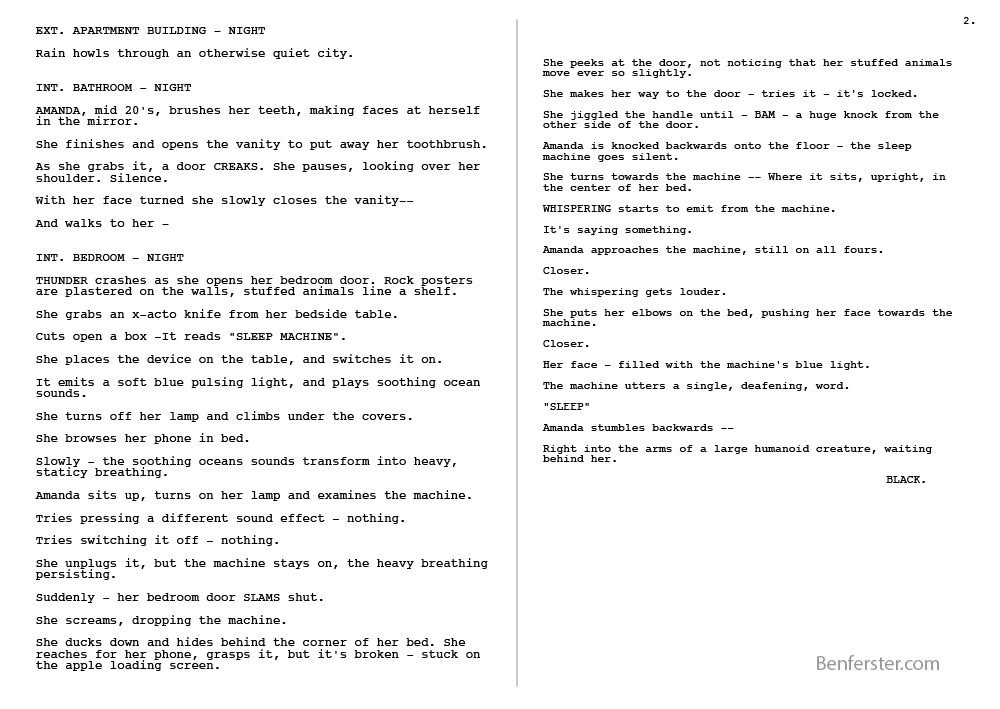
Blocking with blocks
Once that was written, I started on my shot list and storyboards. The first step? Playing with Legos. Setting up scenes using Legos is incredibly quick, satisfying, and fun. It’s also a huge net positive to your creative process. You can experiment and adjust things at the speed of thought. I simply walked the camera and actor through the story a couple times, took some notes here and there, and that was that. I spent less than an hour on this. For longer projects, you might want to take some photos of your Lego setups to help you organize your thoughts for the next step. I think the lego sets are also pretty cool as mementos.
The overhead diagrams
The camera and actor graphic is from the old Celtx Mac app. Some time ago they switched over to only offering cloud-based systems, so, unfortunately, the app is no longer available. But they had a diagramming feature that had some basic props, actors, lights, and camera graphics. I screenshotted the actor and camera graphic and threw them into Photoshop. From there, I drew a rough outline of the set and did the work of placing the camera and actor in the shot, showing the blocking, the camera movements, and setup numbers. They were a little bit annoying to design, but I can’t imagine skipping this step. They helped me visualize the setups we needed, ensure that I had ample coverage, and also helped the AD with scheduling. This is really the first step to bringing the film to life and showing it to others. Everything before this was just in my head. This was real, tangible.Plans to shoot things
I made the shot list on Google Sheets. The Shot Size, Movement, and Location columns are all actually drop down cells. That means that instead of typing “mid shot”, I could just click the cell and select it from a drop-down menu. This was a cool luxury for Sleep Machine, but it can be a huge time saver for a feature-length film.
Drawing with friends
The storyboards were drawn up by producer Jeff Malo in about 30 minutes while we were arguing the merits of curly fries vs “traditional” fries. I attempted doing them myself but quickly realized that my toddler-level drawing skills wouldn’t help anyone understand the shots. I numbered them alongside the overhead diagrams and shot list, but realized later that there were some discrepancies. This didn’t slow us down on set, but in the future, it’s something that I want to make sure I get correct. Here are some of the storyboard pages Jeff illustrated.
Shooting with friends
In October 2016, I got behind the camera again for the first time in quite a few years.
It was something like 14 or 15 hours on set, but it was the quickest time of my life. We had a hard stop because our incredibly talented and gracious camera operator (and lender of 99% of the equipment used), Chris Kennedy, had another gig the next morning. Despite not directing a set for so long, I instantly felt comfortable in my role and had a great time.
The awesome behind the scenes footage below was shot by Abdul Muhsin. Most of the footage includes me, which was pretty intentional. He gave me all the footage and I cut this together to use as a sort of memento from this experience, but then realized that there was no reason why I shouldn’t share it. So, there’s lots of me in it. I think it’s interesting because there aren’t so many BTS videos that show the actual work of directing.
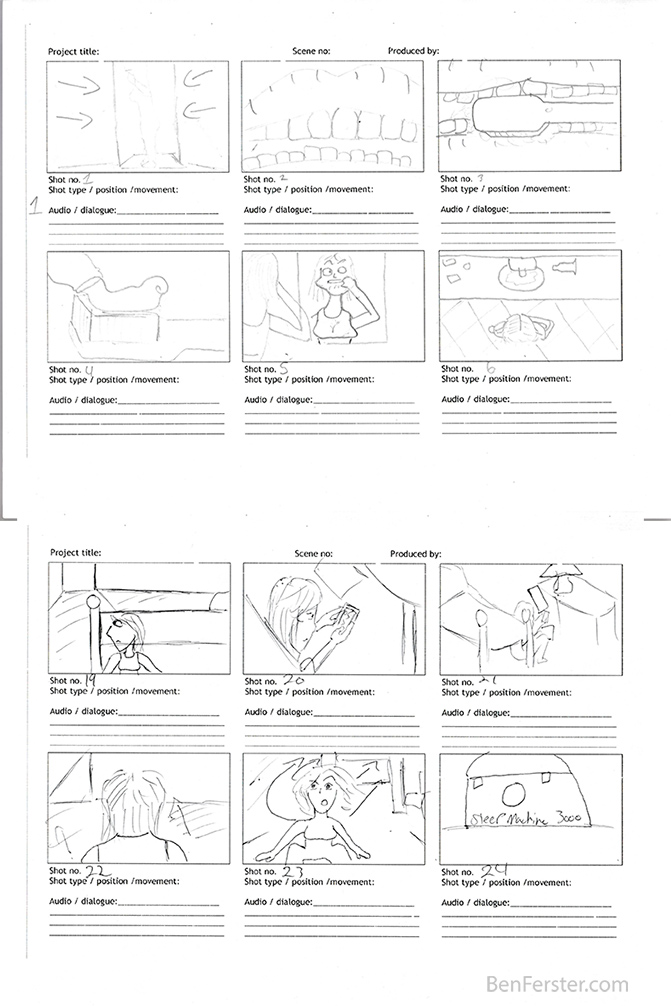
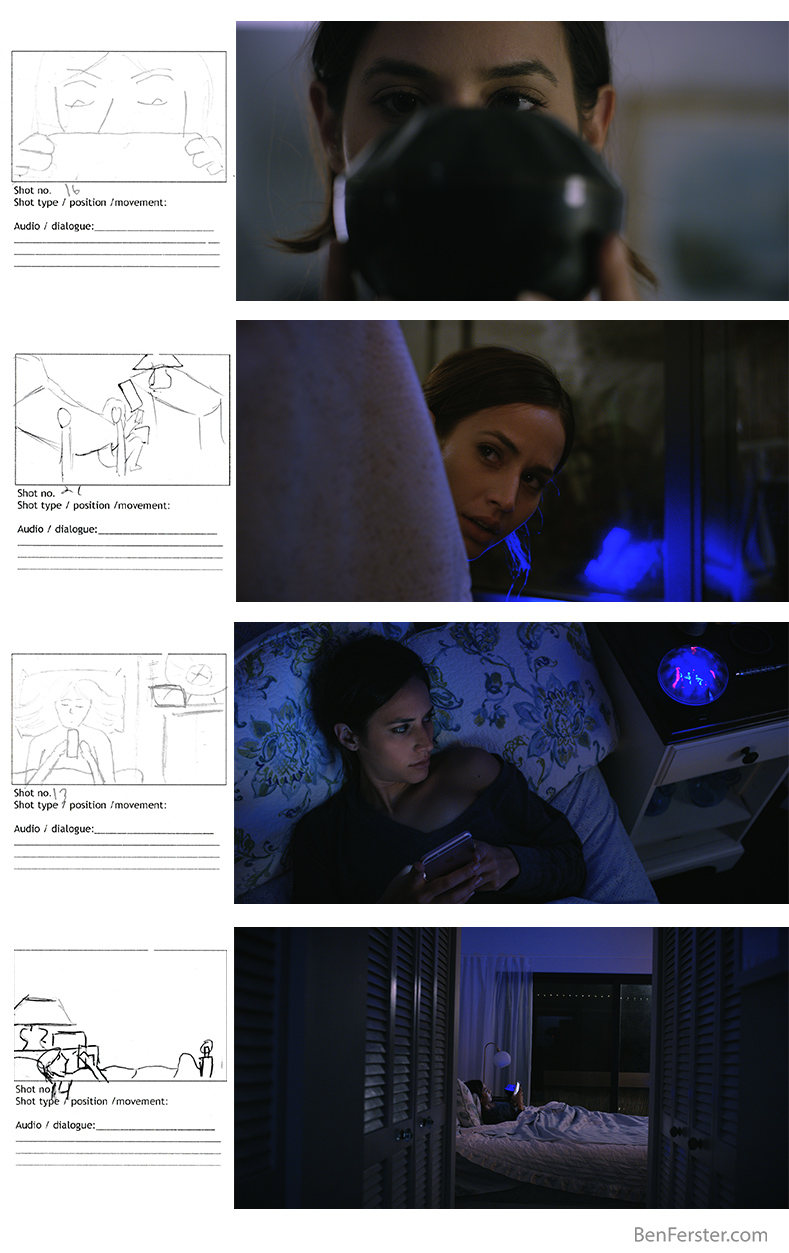
Shooting with friends
In October 2016, I got behind the camera again for the first time in quite a few years.
It was something like 14 or 15 hours on set, but it was the quickest time of my life. We had a hard stop because our incredibly talented and gracious camera operator (and lender of 99% of the equipment used), Chris Kennedy, had another gig the next morning. Despite not directing a set for so long, I instantly felt comfortable in my role and had a great time.
The awesome behind the scenes footage below was shot by Abdul Muhsin. Most of the footage includes me, which was pretty intentional. He gave me all the footage and I cut this together to use as a sort of memento from this experience, but then realized that there was no reason why I shouldn’t share it. So, there’s lots of me in it. I think it’s interesting because there aren’t so many BTS videos that show the actual work of directing.
Faking it
The VFX were done by Silvia Sayas. She was incredible to work with, sending revisions quickly and communicating so well, and I’m really happy to have been lucky enough to work with her. There was no original plan for VFX, but in editing, I realized that the ending shot we got was not at all sufficient. There really was no other option. In the captured shot, we used actor Chris Milan, who I’m naming here because he waited around all night for his 15 minutes of work, which ended up being cut out.
Sounds good!
The sound was a pretty cool situation, as it was done almost entirely in post. The only sounds we recorded on set that made it into the final film were the bed squeaks. This was planned from the get-go, for two reasons:
- We had to move quickly on set, and I didn’t want bad audio to ruin takes.
- The foley sounds I have are much higher quality than we could ever record ourselves.
So I used the audio we recorded audio on set as a reference track and recreated everything from scratch. Syncing things like footsteps is a pain, but it’s so worth it. There are some cues that are a bit off to me, but no one else has been bothered by them. I also did the score for the film. This was super rushed, and I’m not really satisfied with the result. The mixing is off, and it doesn’t build tension the way it should.
Post no bills
I created the poster in about three days. It probably could have gone a lot quicker if I had a faster computer than my 2010 MacBook pro (which I long ago affectionately nicknamed “The Hare”). Since we didn’t take any photos on set, I just used some 2k screen grabs from the film itself. I had to enlarge them up a bit which caused some softening in the images, but by overlaying sharp textures, I increased the perceived clarity of the poster. All in all, I’m really happy with how it came out. The only thing that bothers me is the title text, it’s a little too clean for the poster’s style.
Now showing!
The film premiered at D’Vision Screen Fest 2017. Andres, the organizer, was Sleep Machine’s DP. The event was a lot of fun! The other films were all really great, and it was great to meet so many people in the local scene. Below is a video of me posing with the poster, and following that is a video of me giving a quick introduction to the film.
And here it is! The full film, online for the first time.
Aftermath
So, more than one year since production, and it’s finally online. It’s hard to believe that we shot this so long ago, the time has gone by so fast. I’m insanely proud of myself and the team for getting this thing done. I think it looks good, sounds good, and the acting is great. But while I’m so happy with everyone’s work on set, there is a failure in the script. The way I wrote it, there is tension at the end created by the intercutting cameras and the shortening sentences…but I failed at translating that to the screen. That’s ok. I can happily move on to the next one, learning from this one.
I’m already working on writing my next film. It’s a little more ambitious, a little darker, and there’s actually some dialogue.
Crew
Director
Ben Ferster
Actress
Gleydis Viera
Director of Photography
Andres Sarmiento
1st Assistant Director
Michael Morello
Camera Operator and Executive Producer
Chris Kennedy
Camera Operator
Brandon Lozano
BTS Photographer
Abdul Muhsin
Makeup Artist
Anna Alameda
Gaffer
Rosa Vasquez
AC
Brandon Vecino
Executive Producer
AK Kiaroscuro
Grip
Andy Lizarraga
Producer
Jeff Malo
Producer
Christine Vorsteg
Script Supervisor
Kevin Gandolfo
Actor
Chris Milan
Editor
Stephanie Zinnes
Visual effects
Silvia Sayas
Boom Operator
Francisco Rodriguez
